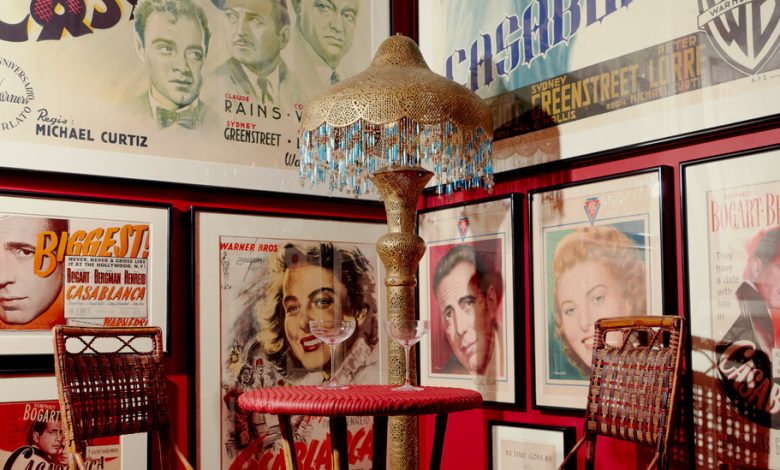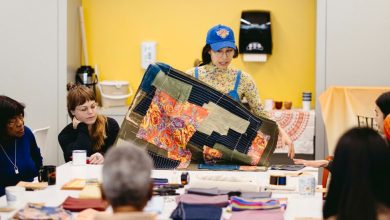‘Casablanca’ and the Romance of the Refugee

Round up the unusual suspects. “Casablanca” has turned 80, and the most esteemed of all Hollywood classics enters its octogenarian years with a new ultra-high-definition DVD release. There’s also, right now in New York, an engaging new display of “Casablanca” artifacts, though you won’t find it at MoMA or the Museum of the Moving Image. Of all the joints in all the towns in all the world, the relics of this paragon of the Hollywood studio system have ended up in … a museum of German and Austrian modern art.
That would be the Neue Galerie, conceived by the cosmetics baron Ronald S. Lauder and the art dealer Serge Sabarsky (1912-1996), which opened in 2001 in a former Vanderbilt mansion on a prime corner of Fifth Avenue. It’s celebrating its first 20 years with a showcase of its surviving founder’s own collection: not only jewels of modern Mitteleuropa, but ancient sculpture, medieval broadswords and reliquaries, and gleaming oddities from Renaissance cabinets of curiosities. Least expected are more than five dozen posters, lobby cards, props and press materials from the collector’s favorite movie, which he reports seeing “at least 25 to 30 times” — and whose memorabilia he has been buying up with foxhound-grade avidity.
“The Ronald S. Lauder Collection” had its grand opening on the evening of November’s midterm elections — whose result, by the way, Lauder may have decisively influenced, having spent millions on lawsuits and campaign advertising for Republicans in New York, where the G.O.P. flipped four congressional seats. (Among his animating causes are crime, taxes, and a proposed wind farm off the Hamptons shoreline.) “I’m no ogre,” Lauder assured The Times this month in an interview at Café Sabarsky, the charmingly ersatz Viennese cafe on the Neue Galerie’s ground floor, and, certainly, the 500-odd objects here do not have an outward suggestion of barbarism. If anything, its rooms of princely baubles are rather oversaturated, as if Lauder didn’t know where to stop; drawings by Egon Schiele are hung sky-high, essentially invisible, and stuffed vitrines induced in me the novel feeling of ivory fatigue.
The unexpected highlight is the “Casablanca” gallery, the show’s smallest and densest, which in its way fits right into an institution devoted to Central European genius and American inheritances. Its walls are covered with soft-focus images of Humphrey Bogart and Ingrid Bergman, and posters both printed and painted. (“They Have a Date With Fate in … CASABLANCA,” reads one hand-lettered display from 1942, the title sparkling gold.) Lobby cards — those black-and-white stills you’d once see by the popcorn stand — take us back to the louche purgatory of Rick’s Café Américain, where the dashing Resistance hero Victor Laszlo (Paul Henreid) is gathering intelligence, and the charmingly corrupt Captain Renault (Claude Rains) is sizing up the loveliest exiles.
You’ll also find memorabilia from the film’s postwar releases in France, Italy, Czechoslovakia and, by 1952, Germany. Bergman appears in solo splendor on the German poster, beaming above a set piece of fez-topped musicians. There’s a brass lamp from Rick’s, fringed with imitation gemstones, and two rattan chairs where Europe’s desperate and displaced drank their cognacs and plotted their escapes. Looping in the background is “As Time Goes By,” performed by Dooley Wilson, a veteran of the Negro Theater Unit of the Federal Theater Project, in the role of the nightclub crooner Sam. Lauder apparently also owns the 1940 Buick Phaeton in which Rains drives our heroes to the Casablanca airport in the film’s final act. Lauder wanted to station the car outside the Neue Galerie for the run of the show, but no dice. Even with a net worth of $4.5 billion, nobody beats alternate-side parking regulations.
“Casablanca” premiered in New York on Nov. 26, 1942; Warner Bros. pushed up its release date to capitalize on the excitement around that month’s Allied invasion of North Africa. It opened nationally in January 1943, and its tale of refugees and people smugglers was not only topical; it was nearly autofiction. A stunning number of its performers were Jewish refugees or anti-Nazi exiles — among them Conrad Veidt, previously a star of the Berlin studio system, who played Major Strasser; S.Z. Sakall, a Hungarian Jewish actor, as the club’s affable headwaiter; and Peter Lorre in the small but crucial role of Ugarte, who sells exit visas to the rich and desperate. The French actress Madeleine Lebeau, in the small role of Rick’s jilted mistress, cries real tears during the film’s stirring performance of “La Marseillaise”; she too was a refugee, fleeing via Lisbon to Mexico, and then to Hollywood. She escaped with her husband, Marcel Dalio (born Israel Mosche Blauschild), who plays the croupier at Rick’s, and who left France after antisemitic critics denounced his appearance in “The Rules of the Game.”
When it plays in the revival houses on Valentine’s Day, when it surfaces as the late movie after “Nightline,” “Casablanca” still endures as a wartime love affair, with Bogie and Bergman letting each other go in the airport fog. But for me “Casablanca” has always been a movie of visas and exit stamps, embassies and expediters, bribed officials and underground operators. It paints the modern world as the province of emigrants and evacuees, and subordinates the most enthralling of all Hollywood romances to the welfare of the persecuted. Which is why I was so astonished to discover, in Lauder’s collection, an extraordinary relic: the original (prop) letter of transit that sets the plot in motion, made out to Victor Laszlo and “signed” by General de Gaulle. The prop passports are here too, with Bergman’s and Henreid’s photographs stamped with the seal of the Casablanca colonial administration.
I couldn’t believe I was seeing them, and seeing them here, in a museum of German and Austrian art. It was as if these fictional travel documents concentrated all the exiles and displacements that built midcentury American culture, of Mies van der Rohe and Marlene Dietrich, of “Doctor Faustus” and “Broadway Boogie-Woogie.” They burn, especially, with the shame of knowing that a contemporary “Casablanca” cast member could probably not procure one. Even before the Russian invasion of Ukraine, which has forced an estimated five million to flee, the world has been shaken by the largest refugee crisis since everybody came to Rick’s. The United Nations now puts the number of displaced at 100 million — one in every 78 people on Earth — from Afghanistan and Venezuela, from Central America and Myanmar, and above all from Syria, whose civil war will soon enter its 12th year.
Nevertheless, under President Donald J. Trump, the United States cut its quotas for refugee admissions to the lowest level ever. The numbers have barely budged under his successor. Though President Biden increased the cap of the refugee admissions program, his government has come nowhere close to fulfilling it; just 25,400 refugees were admitted in the last fiscal year, leaving 80 percent of the places unfilled.
The fundamental things apply. In “Casablanca” the Hollywood system reached the acme of its artistic and civic potential, and on that Orientalist soundstage, as the displaced of Europe oscillated in and out of character, these foreigners offered America a new self-portrait. It taught us that love and displacement went hand in hand, that ideals were thicker than blood. “I bet they’re asleep in New York,” Bogie mopes into his tumbler of whisky at the end of the first reel. “I bet they’re asleep all over America.” But the passionate clarity of “Casablanca” was not something we only dreamed.
The Ronald S. Lauder Collection
Through Feb. 13, Neue Galerie New York, 1048 Fifth Avenue, 212-628-6200; neuegalerie.org.




